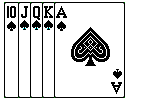| Author |
Message |
valeria
Royal PCer

Joined: 28 Feb 2006
Posts: 1825
Location: Springfield, Oregon
 75217 75217
 2000 2000
 0 0
 1500.00 1500.00


|
 Posted:
10.01.2007, 00:36 Posted:
10.01.2007, 00:36 |
  |
PreFlop Hand Comparisons ---PARDON THIS INTRUSION, PLEASE. I INTERRUPT DEAR VALERIA'S POST TO ASK ALL PCers NOT TO READ IT OR GIVE IT ANY IMPORTANCE TO YOUR PLAYING OF POKER! YOU KNOW, I HOPE, THATI WOULD NOT DO SOMETHING THIS DRASTIC UNLESS I CONSIDERED MY ACTION TO BE IN YOUR EXTREME, VERY EXTREME BEST INTEREST. PLEASE READ MY POST JUST BELOW THIS ONE. THANK YOU. FORGIVE ME, DEAR VALERIA. --- YOUR GURU
To get an idea of the value of your hand, you need to know how it would stand up against other hands. You can calculate your pot odds preflop quite easily but the problem is that you have no factor to weigh against it. This often leads to tough decisions in the blind positions whether a bad hand is worth calling a raise because of the odds offered. Below are a list of the common groupings of hands vs other hands along with the percentage so your have a better idea of when to call with garbage. The percentages expressed are the chance of one hand winning against another if they go all the way to the showdown.
Pocket Pair vs. Smaller Pocket Pair
(ex. KK vs. 66)
80% vs. 20% in favor of the bigger pair. It varies based on distance from each other (because then they interfere with straight-making). If they are close (AA vs. KK), it gives strength to the higher pocket pair. Having the similiar suits also gives strength to the higher pocket pair.
Pocket Pair vs. Two Overcards
(ex. 77 vs AK)
This is the typical coin flip situation, typically 55% vs. 45% in favor of the pocket pair. Note a hand like Jack-Ten suited vs. a small pocket pair (55 or lower) actually has the edge because the pair does not interfere with Jack-Ten's straight making ability.
Pocket Pair vs. Two Undercards
(ex. QQ vs. T
80% to 20% in favor of the pocket pair. The two undercards actually vary between 14% and 23%. That's based on the suits and if the two overcards interfere with their ability to make a straight.
Pocket Pair vs. One Overcard and One Undercard
(ex. TT vs. K9)
70% to 30% in favor of the pocket pair. It also helps the over/over hand by 1% or so if it is an Ace and a 2,3,4, or 5, because in those cases the pocket pair doesn't interfere with your straight chances.
Pocket Pair vs Same Card and One Overcard
(ex. JJ vs. AJ)
Almost the same as the above scenario, 70%-30% to 65%-35% in favor of the pocket pair. The pocket pair's advantage can end up as low as 60% if it's against middle-suited connectors.
Pocket Pair vs Same Card and One Undercard
(ex. AA vs. AK)
This is the worst situation you can be in. Uber-dominated. It's around a 85% to 15% chance in favor of the pocket pair. Even if the pocket pair is up against a suited connector, it is at best 80% to 20%.
Two Overcards vs. Two Undercards
(ex. KQ vs. JT)
This one often surprises beginners. It's typically 65% to 35%. If the undercards are significantly far enough away from the overs and suited without matching an overcard's suit, it can reduce the advantage to as much as 60% to 40%.
Overcard & Undercard vs. two middle cards
(ex. A9 vs. QJ)
This is usually around 60%-40% in favor of the overcard/undercard. It can reduce the advantage to 52% to 48% with a middle-suited connectors that don't share a suit with the over/under and where there is no straight interference. Something like A2o vs 89s.
1st and 3rd Highest vs. 2nd and 4th Highest
(ex. KJ vs. QT)
Varies from a 70%-30% to a 60%-40% advantage for the 1st/3rd hand but mostly just falls around a typical 2 to 1 edge for the guy with the highest card.
Dominated with same high card
(AQ vs AT)
Usually the person with the high kicker wins 2 out of every 3 times, but as the kickers get lower, the edge starts to disappear because of split pot possibilities.
Dominated with same low card
(KT vs. AT)
The dominated hand has at best around 40%, if it's a suited connector vs. two unsuited cards without poor straight potential. Otherwise it's 2 to 1 in favor of the higher hand. If the low cards are really low (A3 vs. A2), there is a significant chance of a split pot, which would give an edge to the dominated hand.
Same ranks
(87 vs 87)
If it's suited vs. offsuit, the suited cards gain a 2.5% edge. In any other case, it'll be 50%-50% (surprised?). |
_________________
    |
|
 |
 |
PokerGuru
Royal PCer

Joined: 16 Nov 2005
Posts: 2913
Location: Florida USA
 130972 130972
 2000 2000
 0 0
 1500.00 1500.00


|
 Posted:
10.01.2007, 13:29 Posted:
10.01.2007, 13:29 |
  |
DEAR ALL, especially Valeria,
THIS IS IMPORTANT!
Ijust "lost" an hour's work, typing a reply to Valeria's post above. I am so mad I could spit nails! Mad only at myself.
In what I wrote, I was very polite. BUT.........unttil I find time to compose another point-by-point reply to the message above............
PLEASE, my PCers, IGNORE EVERYTHING IN THAT POST!!!!!!!!!!!!
Trust me, Valeria. I will give you the reasons very shortly.
AGAIN:
POKER CRUSHERS:
DO NOT WASTE TIME LEARNING THE "STUFF"IN THE MESSAGE ABOVE!!!
It would only work if we lived in a perfect world and all of us were exactly alike, were robots designed by just one human mind, and could predict ahead of time how every other person at the table would act with any combinations of cards.
It looks great on paper, but it does NOT WORK in real life........and YOU SHOULD NOT CLUTTER YOUR MIND WITH IT!!!
Your Poker Guru, speaking for your best interest |
_________________
    |
|
 |
 |
valeria
Royal PCer

Joined: 28 Feb 2006
Posts: 1825
Location: Springfield, Oregon
 75217 75217
 2000 2000
 0 0
 1500.00 1500.00


|
 Posted:
10.01.2007, 16:01 Posted:
10.01.2007, 16:01 |
  |
I think I already understand what you are saying Guru! Yes it may hold true IF it were a Perfect world and EVERYONE played the same, which of course isn't the case.
I assume it should be taken lightly as odds not doctrine. I thought it would be sort of like a poker chart I had posted a few months back. Just something to help get the edge a little.
SEEEEEEEEEEEEEE everyone? Poker Guru is really looking out for us 
Thank you Poker Guru! |
_________________
    |
|
 |
 |
|
|
|
|


 75217
75217 2000
2000 0
0 1500.00
1500.00
 130972
130972 2000
2000 0
0 1500.00
1500.00
 75217
75217 2000
2000 0
0 1500.00
1500.00